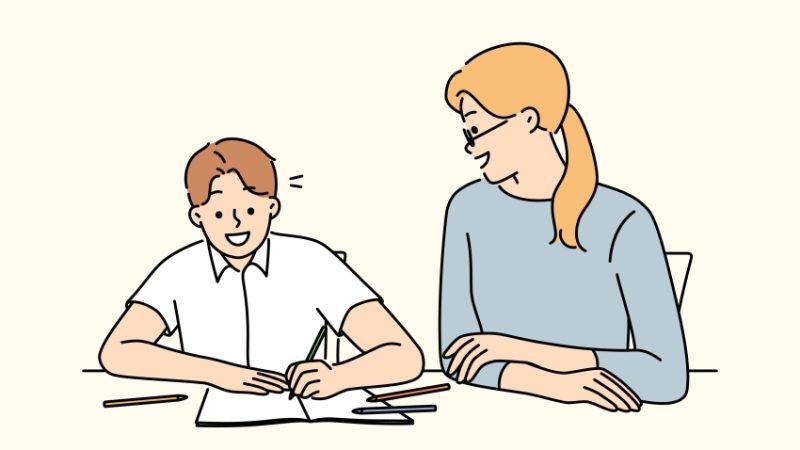Distance CPD – Keep boundaries between the personal and professional

The explosion in remote CPD has been enriching, but also made it harder for many to stay organised and focused, observes Rebecca Leek…

- by Rebecca Leek

There’s a watercolour technique which involves painting onto already wet paper.
It’s quite magical – as the tip of your paintbrush hits the page, the colour floods outwards, like a flower in bloom. Add another colour, and you’ll witness a slow amalgamation as the two tones blur with one another.
I learnt about watercolour techniques during lockdown. In those first few weeks, despite my children’s schools mobilising magnificently, there was still lots of time for us to fill. I ordered an ‘art-in-a-box’ watercolour set, watched some YouTube videos and planned some activities to do with my three daughters. I still have some of the art we created together.
I also applied my newfound knowledge back at the primary school where I was appointed headteacher following lockdown. We had settled on watercolours as one of our ‘mastery building blocks’ – the children would visit different media during their time with us, but we wanted them to develop a facility in one really well. Watercolours are affordable, so every child received their own watercolour set.
Self-sourced CPD
Unwittingly, I’d arranged some self-sourced CPD for myself. It was interesting, cheap and could be fitted around childcare and emails. It really taught me something, contributed to my sense of purpose and wellbeing, and ultimately improved the quality of education the children received at school.
Since I first started teaching, the nature of CPD has changed dramatically. A year into my career, I remember travelling all the way from Hertfordshire to York for a one-day course on attaining higher grades at English GCSE. I can still remember some aspects of it now, 16 years later, so it certainly had an impact. Upon my return, I had to fill in a one-page sheet outlining what I’d learnt. This was filed away somewhere by the deputy headteacher, and I never saw it again.
The likelihood of me, or indeed any teacher now ever spending more than five hours travelling to and from a day’s training – to the tune of £150 for the train ticket alone – is very low. It does happen, but has become far rarer.
The range of what you can presently access online is kaleidoscopic. If I was someone with money to invest I’d be putting it in the e-learning sector, as the growth rates are eye-watering.
Dividing lines
But just as watercolours can flow into each other across a page, so too can the boundaries between work and school. We can access CPD modules on our phones. Who else has sat in bed completing online safeguarding training when the last thing our tired eyes need is blue light messing with our circadian rhythms? I know I have.
Already exposed to long work hours, our dividing lines can start to blur. Teachers are constantly being told to build up their professional network, read the latest research, listen to podcasts, even write their own reflective blogs. These are laudable activities, but how can we prevent this online activity from seeping into our every waking hour?
When we fire up our phones or laptop to, for example, participate in a webinar, we’re also opening the door to all our other work – emails, that policy we’re updating, Twitter. It’s tempting to hop between tabs and rattle off a few different tasks simultaneously, but this lack of boundaries produces diminishing returns. Since we’re not really focusing on anything, neither the work nor the learning will be as efficient or as effective as it should be.
Compartmentalise
The solution is to reduce the seepage between different parts of your work and personal life. Set aside specific times for marking and your professional studies, and enter them in your diary. If a webinar is being recorded, allocate a slot for watching it at a time that suits you.
Plan homework over a cycle of lessons, not just one at a time. Check in with emails at set intervals over the course of the day, and establish a new norm of only responding at 8.15am and 4.15pm (or whichever times suit you best).
Use productivity apps like Forest to help you stay focused on the task at hand, rather than constantly checking your phone. As you systematise your working days, you should soon find that your upcoming tasks start receiving the attention they deserve at those pre-planned, allotted times.
Innovate and improve
I’ve attended some terrible webinars. Some were too long, others lacked any form of interaction built into the delivery. In essence, they were demonstrations of very poor teaching – which for a teacher, is infuriating.
When delivering anything online, be it a staff briefing or in-school training, make sure you do it well. Invite responses in the chat. Integrate some quizzing. Send out some pre-reading. Maybe even encourage some friendly heckling.
Similarly, be brave and give feedback following any events you attend. The craft of ‘e-teaching’ is still quite new, and we have a responsibility to improve how it’s done. Let people know what went well and how the session could have kept you more on your toes. If at any point you drifted into checking your inbox, it probably wasn’t good enough.
Choose wisely
The menu of what’s out there is truly vast and can be difficult to navigate. Before anything else, think carefully about what you want to learn, achieve and become in the next two to three years.
You might be considering something substantial, like a postgraduate qualification, or conversely, some bite-sized sessions in a few key areas to strengthen your subject knowledge. If you’re planning on working through an online video series, keep a log and build in some peer reflection time to talk about your learning.
Also, don’t assume that providers which specialise in education training are the only platforms worth considering. If you’re interested in pursuing leadership, completing cross-disciplinary courses in areas such HR and change management might well set you apart from other candidates.
Most importantly, think carefully about how you’re going to fit all this learning into your already busy working week. A desire to go above and beyond is admirable, but there’s no honour in finishing the day knowing you’ve spent much of it unproductively hopping between screens or inefficiently multitasking.
Set yourself some boundaries, compartmentalise your time – and leave the blending and blurring for when you next get the paintbrushes out…
Find your focus
Deep focus
My favourite app for aiding focus whilst working is Forest. While the app is running, it will grow a small tree, and over time, a virtual forest – but when you try using your phone for something else, the tree will die. Subscribe to the paid version, and you’ll contribute to trees being planted in the real world.
Buddy up
There’s a strategy in ADHD circles known as ‘Body Doubling’. People have discovered that they’re more likely to focus on tasks if there’s a second person in the room also focussing. Try finding a buddy and sit together. You can be working on different things while wearing headphones, since it’s the physical, focussed presence that has been proven to help.
Rebecca Leek has been a secondary and primary classroom teacher, head of department, SENCo and headteacher; she is currently the CEO of SEAMAT – a trust of three schools in South Essex











